Hearty Fall Minestrone Soup: A Nourishing Vegan Delight with Butternut Squash & Kale
Embrace the vibrant flavors of autumn with our incredibly satisfying and healthy Fall Minestrone Soup. This robust vegan recipe is brimming with seasonal treasures like sweet butternut squash, nutrient-dense kale, and an assortment of hearty root vegetables, all swimming in a rich, savory homemade broth. It’s more than just a soup; it’s a complete, wholesome meal that promises warmth, comfort, and deep nourishment in every spoonful. Perfect for chilly evenings, this easy-to-prepare dish is also a fantastic option for meal prepping and is wonderfully budget-friendly, making healthy eating accessible to everyone.
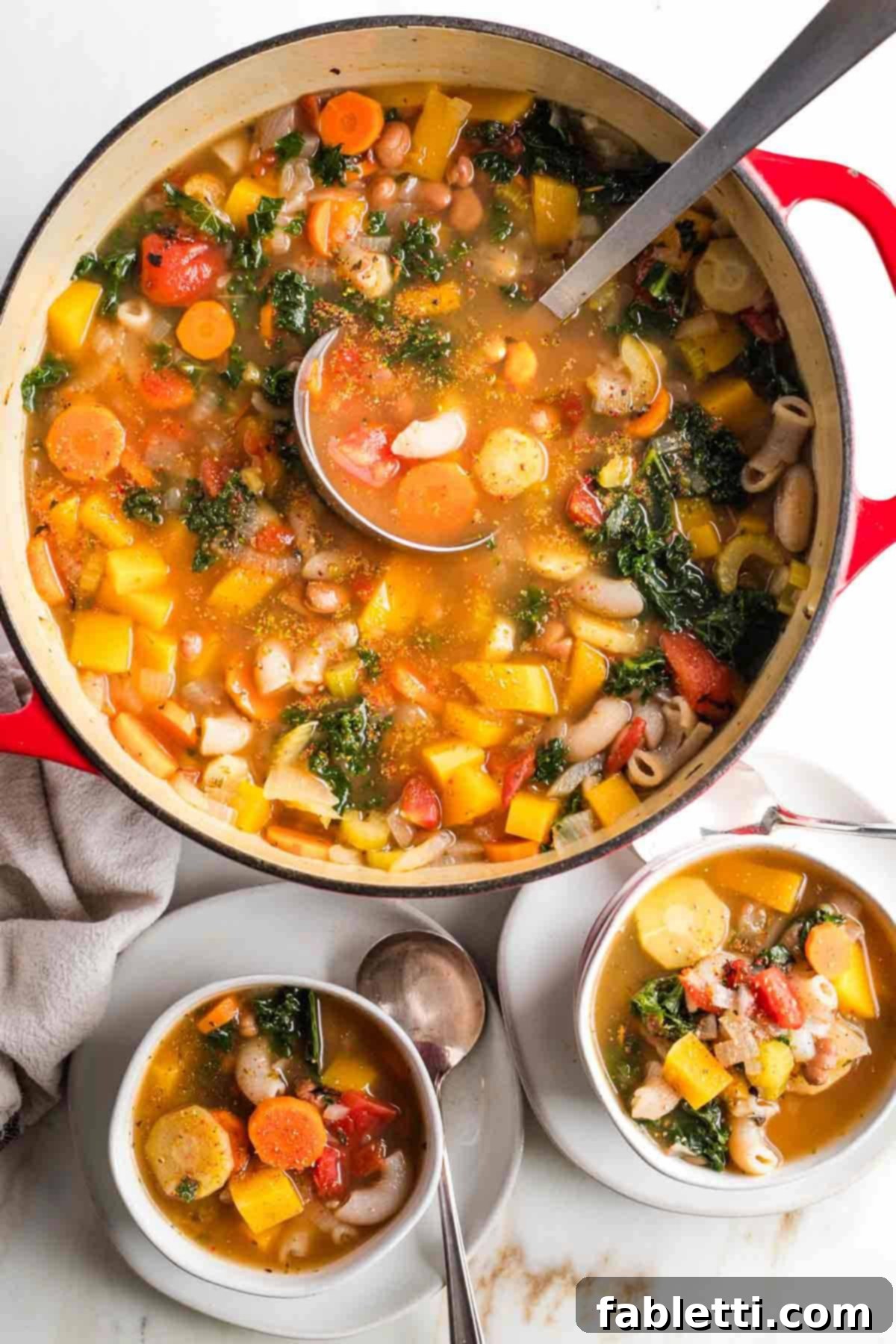
The autumn harvest generously provides us with an abundance of winter squash, making it the ideal time to create flavorful and fulfilling seasonal soup recipes. While a silky pureed butternut squash soup is always a delightful choice, this easy-to-make, chunky vegan minestrone offers a fantastic alternative to savor the unique sweetness and texture of butternut squash in a new and exciting way. This recipe celebrates the simplicity of whole foods and the incredible flavors they bring when combined into a single, heartwarming dish.
Our vegan minestrone soup is a true celebration of autumn’s bounty. It’s generously packed with wholesome seasonal vegetables like tender butternut squash and vibrant kale, along with earthy carrots and parsnips. We boost the nutritional profile and heartiness with plant-based protein from a variety of beans, all brought together by a deliciously aromatic easy homemade vegetable broth. This ensures every bite is bursting with incredible taste and goodness. Finally, you have a wholesome, plant-based dinner that genuinely appeals to everyone at the table, proving that healthy can be utterly delicious and deeply satisfying!
Essential Ingredients for Your Fall Minestrone
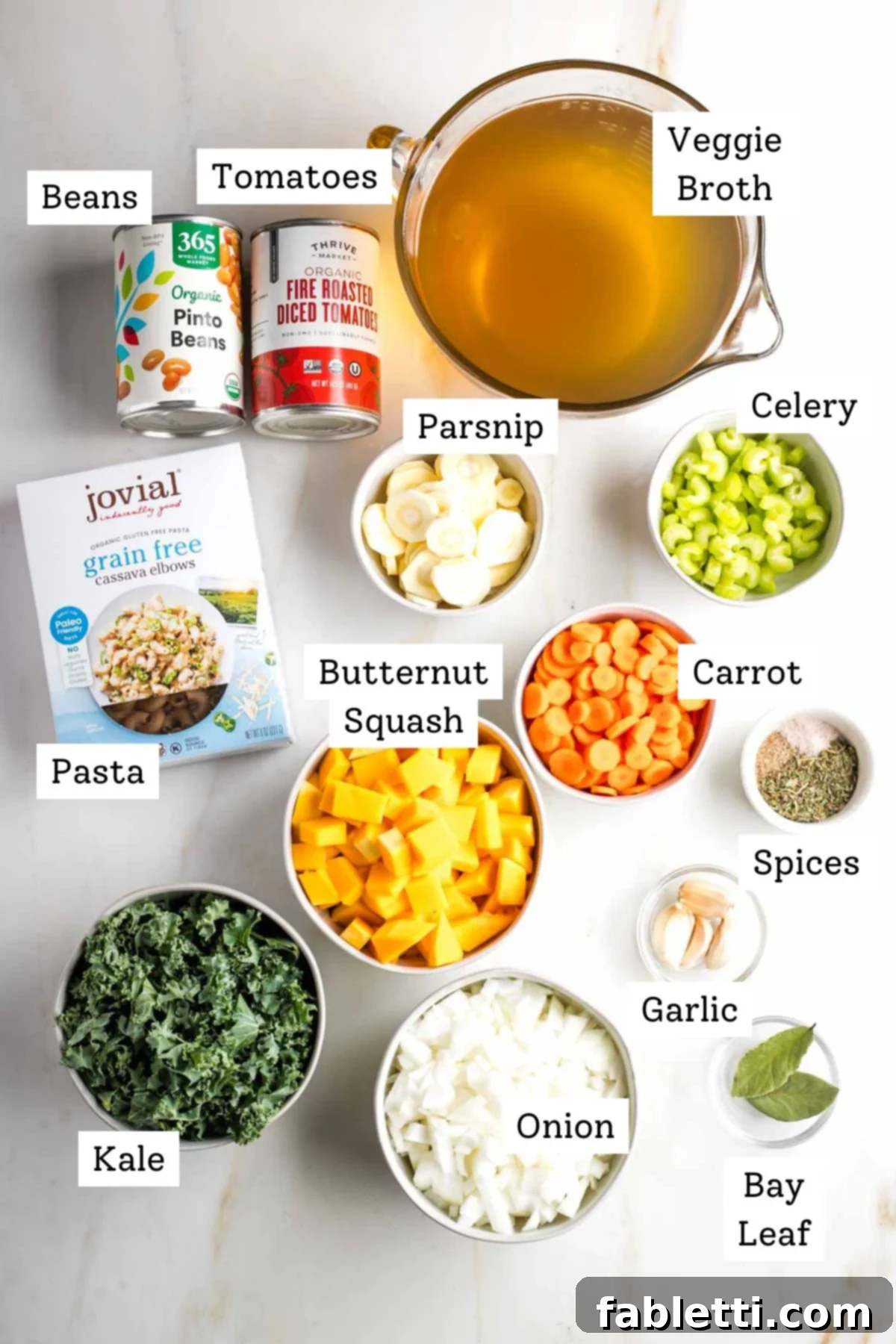
Crafting the perfect Fall Minestrone begins with selecting quality ingredients. Each component plays a crucial role in building the soup’s depth of flavor, nutritional richness, and comforting texture. Here’s a closer look at the key elements that make this soup a stand-out:
Beans: Your Plant-Based Protein Powerhouse
Beans are a cornerstone of this hearty vegan minestrone, providing an excellent source of plant-based protein and dietary fiber. This dynamic duo not only helps to regulate blood sugar levels but also promotes a feeling of fullness and satisfaction, making this soup truly filling and energizing. The beauty of beans is their versatility; feel free to use what you have readily available in your pantry. Great choices include pinto beans, kidney beans, chickpeas, cannellini (white) beans, or even a mix for added texture and complex flavor. Always remember to rinse and drain canned beans thoroughly before adding them to the soup to remove excess sodium and improve their digestibility.
Butternut Squash: The Star of Autumn Flavors
Butternut squash brings a delightful natural sweetness and creamy texture to our minestrone, embodying the quintessential essence of fall. This versatile winter squash is packed with essential vitamins A and C, offering powerful antioxidant benefits that support overall health. Its firm flesh holds up exceptionally well during cooking, adding beautiful color and a tender, yielding bite to the soup. If butternut squash isn’t available or you’d like to experiment with other seasonal produce, any hard winter squash will work wonderfully. Consider acorn squash, kabocha, hubbard squash, or even a sugar pumpkin for a slightly different yet equally delicious flavor profile. Sweet potatoes or yams are also excellent alternatives, adding similar sweetness and a wealth of nutritional value.
Vegetable Broth: The Foundation of Flavor
The quality and flavor of your vegetable broth significantly impact the overall taste and depth of your minestrone. For ultimate control over ingredients and sodium content, I highly recommend making your own easy homemade vegetable stock. It’s surprisingly simple to prepare and offers a fresh, clean taste that store-bought versions often lack. I often prepare a large batch and keep it frozen in convenient portions for impromptu soup-making anytime. If you opt for store-bought veggie broth, be sure to read the ingredient list carefully. Many commercial broths contain highly processed vegetable oils, artificial flavorings, and excessive amounts of sodium, which can detract from the soup’s natural goodness and health benefits. Choose low-sodium or unsalted varieties whenever possible to best control your seasoning.
Pasta: Heartiness and Texture
Pasta adds a comforting heartiness to minestrone, transforming it into a substantial and incredibly satisfying meal. I personally used Jovial Brand Grain-free Casava elbow pasta for its excellent texture and gluten-free properties. However, you can substitute it with any small pasta shape that suits your dietary needs or preferences, such as ditalini, small shells, orecchiette, or even broken spaghetti. A crucial tip for achieving perfect minestrone texture, especially for meal prepping, is to cook the pasta separately and for slightly less time than the package instructions suggest (al dente). This prevents the pasta from becoming mushy and absorbing too much broth, which can thicken the soup considerably over time. If you prefer to cook the pasta directly in the soup, be prepared to add an additional 2 cups of liquid (broth or water) to maintain the desired soup consistency.
Kale: The Nutrient-Dense Green
Kale is a nutritional powerhouse and a fantastic, vibrant addition to any fall soup. Its robust, somewhat firm texture means it holds up beautifully during cooking without completely disintegrating, unlike more delicate greens such as spinach. For this recipe, opt for hearty varieties like Swiss chard, collard greens, red or green curly kale, or lacinato kale (also widely known as Tuscan or dinosaur kale). These greens offer a slight, pleasant bitterness that perfectly balances the natural sweetness of the squash and root vegetables, while simultaneously infusing the soup with essential vitamins (especially K, C, and B6) and vital minerals. Preparing kale simply involves removing the thick, fibrous ribs, which can be tough, and then roughly chopping the leaves into bite-sized pieces.
Exploring the Nutritional Power of Kale in Your Soup
Incorporating kale into your Fall Harvest Minestrone is an excellent way to eat seasonally while benefiting from the incredible energy and dense nutrition this leafy green provides. Kale is particularly well-suited for autumn and winter dishes due to its robust nature; it thrives in cooler temperatures, making it a sustainable and readily available option, unlike more fragile greens that might wilt easily.
- Seasonal Superfood: Tuscan Kale (also known as Lacinato kale or dinosaur kale) is not only hardy and visually appealing with its dark, crinkly leaves, but it’s also packed with an impressive array of nutrients. Its sturdy leaves maintain a pleasant, slightly chewy texture even after simmering in the soup, preventing the dreaded “soggy greens” dilemma that can affect other vegetables.
- Vitamin-Rich: Kale is an exceptional source of vital vitamins, including a significant amount of Vitamin K, which is crucial for blood clotting and bone health, Vitamin C, a powerful antioxidant and immune booster, and Vitamin B6, important for metabolism and brain function.
- Mineral Boost: Beyond its remarkable vitamin profile, kale also provides a good source of Thiamin, Riboflavin, and Iron, all contributing to energy production, red blood cell formation, and overall vitality. For more detailed nutritional information and scientific backing of its health benefits, you can explore reputable resources such as Healthline’s proven benefits of kale.
- Texture and Taste: I personally love how hearty kale is in a soup. I’m not a fan of soggy greens, but a perfectly wilted Tuscan kale that still offers a slight chew and a burst of fresh, earthy flavor? Sign me up! It adds a beautiful color contrast, a healthy dose of greens, and a wonderfully satisfying texture to every spoonful of minestrone.
Crafting Your Delicious Fall Minestrone: A Step-by-Step Guide
Making this hearty minestrone is a straightforward process that yields incredibly satisfying results. Follow these detailed steps to create a comforting and nutritious meal that will become a staple in your autumn repertoire:
Step 1: Prepare Your Foundation Vegetables
Begin your culinary journey by meticulously preparing your vegetables. Dice the yellow onion into small, even pieces. Thinly slice the carrots, celery, and parsnips to ensure they cook evenly and integrate seamlessly into the soup. For the garlic, use a microplane to finely grate it directly into the pot, or opt for a garlic press to achieve a smooth consistency. Proper and uniform preparation of your aromatics ensures even cooking and maximum flavor release, building a strong base for your minestrone.
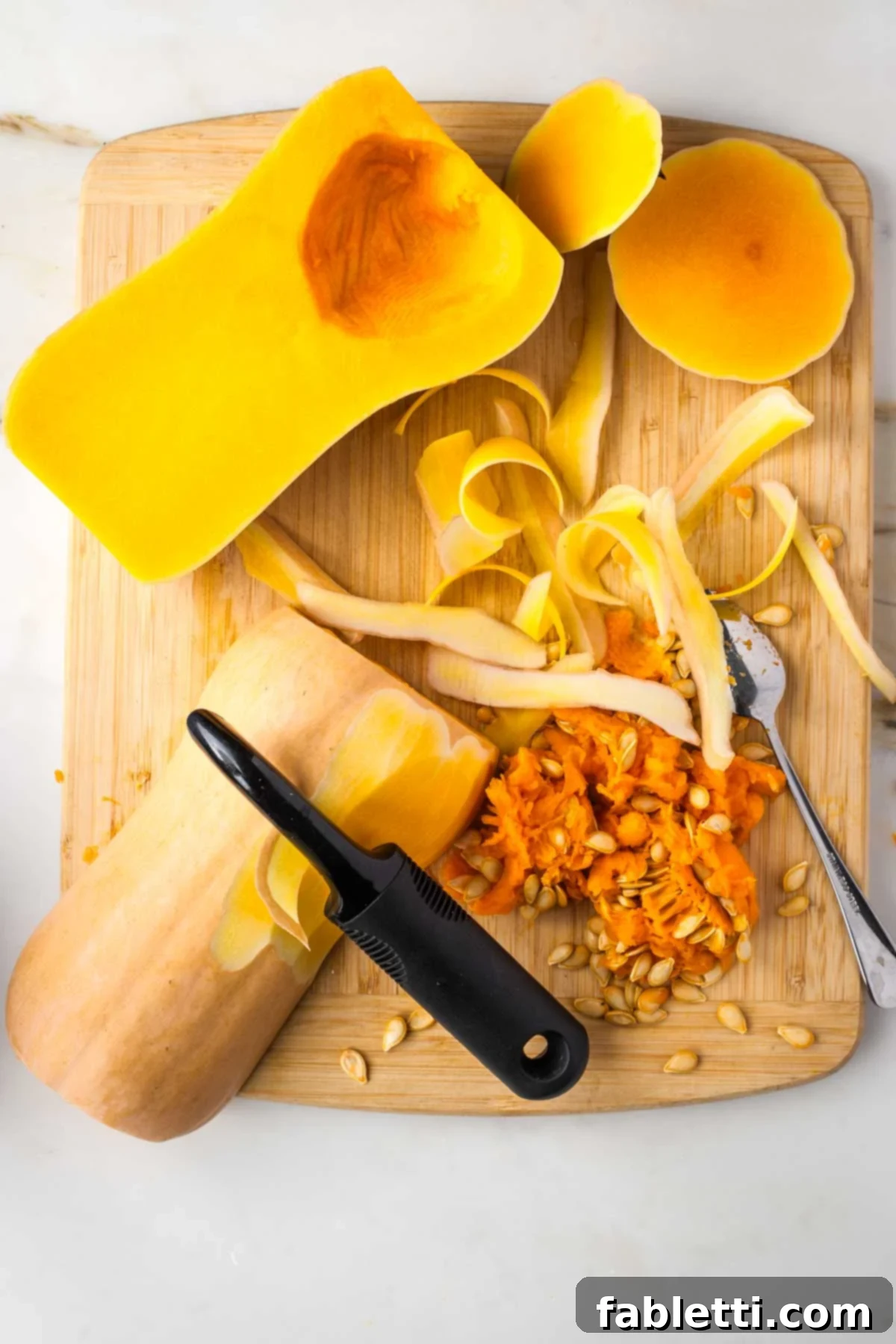
To prepare the butternut squash, first trim a thin slice off both the top and bottom ends to create stable, flat surfaces. Carefully cut the squash in half lengthwise. Next, use a sturdy spoon, or even better, a grapefruit spoon (which makes this task incredibly easy and efficient), to scoop out all the seeds and fibrous strands from the center. Finally, use a high-quality vegetable peeler to effortlessly remove the tough outer skin. This ensures you’re left with only the sweet, tender, edible flesh of the squash.

Once peeled, place each squash half cut-side down on your cutting board for maximum stability and safety. Make ¼-inch lengthwise slices across the squash. Then, turn the squash and cut again in the other direction to create small, uniform cubes. These smaller, evenly sized pieces will cook more quickly and consistently, ensuring they are tender but not mushy when added to the soup, contributing perfectly to the minestrone’s chunky texture.
Step 2: Sauté the Aromatics and Spices to Build Flavor
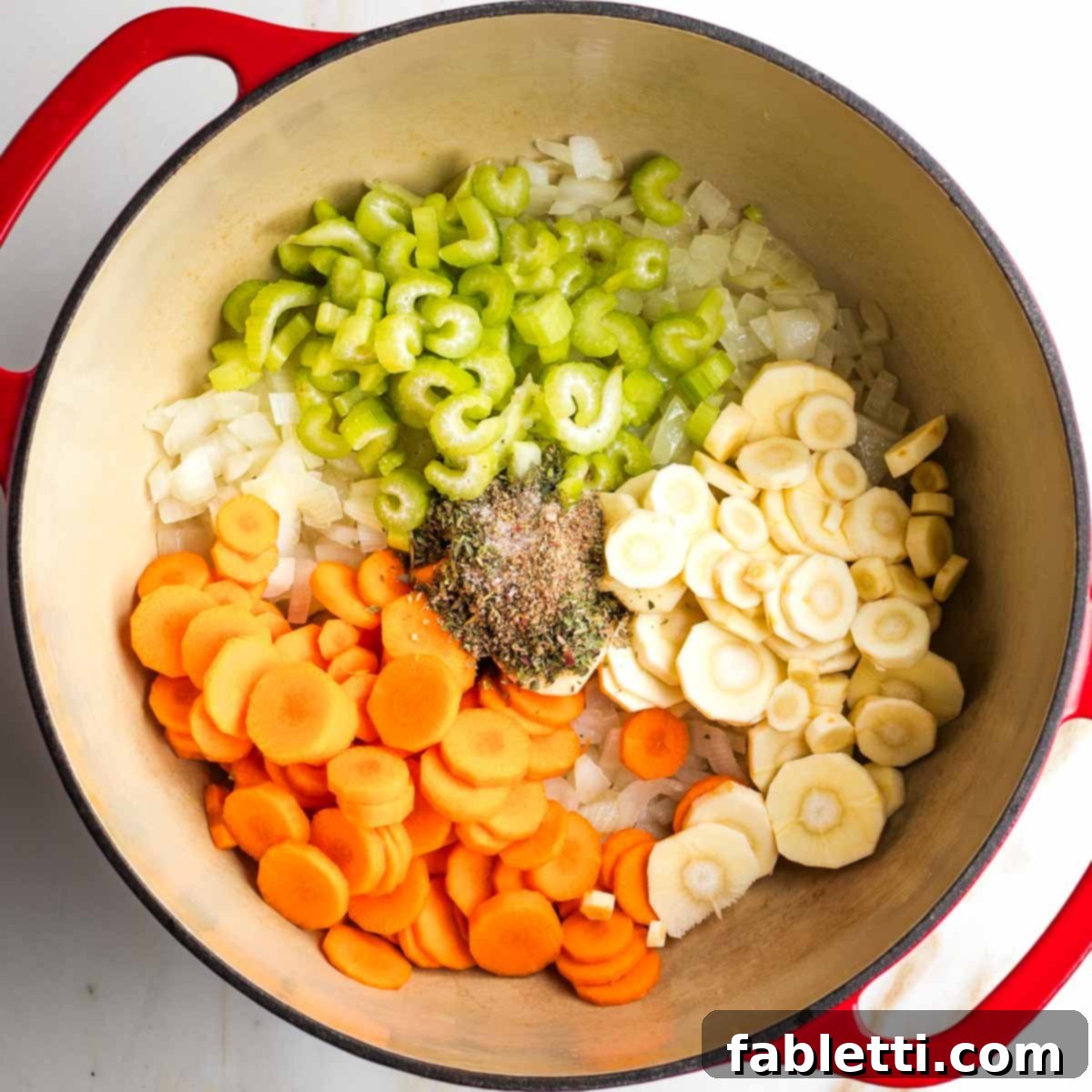
Heat a sturdy dutch oven or a large, heavy-bottomed soup pot over medium heat. Add a generous splash of olive oil or a tablespoon of vegetable broth, then add the diced onion. Sauté the onion until it becomes translucent and begins to soften, which typically takes about 3-5 minutes. Next, add the thinly sliced carrots, celery, parsnips, and your carefully selected Italian spices. Continue to cook and stir frequently for about 5-7 minutes, allowing the vegetables to gently soften and the spices to become wonderfully fragrant, releasing their aromatic oils. Remember, if you’re using my no-salt veggie broth recipe, you may need to add a bit more salt at this stage to enhance the overall flavors of the vegetable base.

Continue cooking and stirring the vegetables until they are tender-crisp. If the bottom of the pan starts to look dry or the vegetables begin to stick, add veggie broth one tablespoon at a time to deglaze the pan, scraping up any flavorful browned bits, and prevent burning. Once the vegetables are adequately tender, use a microplane or garlic press to add the minced or pressed garlic directly over the pan. Stir well and cook for only about 30 seconds until the garlic becomes intensely fragrant, taking extreme care not to let it burn, as burnt garlic can impart a bitter taste to your soup.
Step 3: Combine and Simmer to Perfection
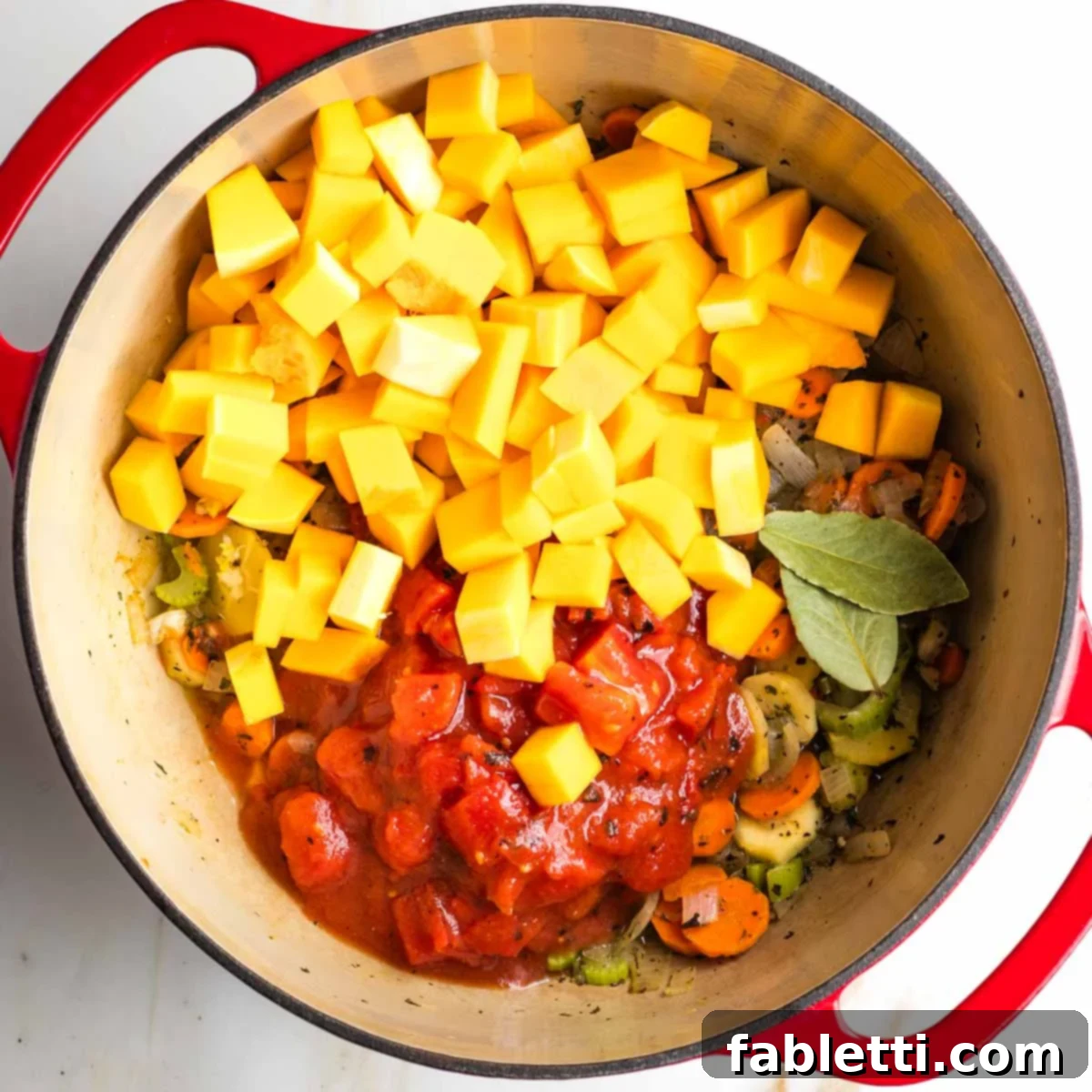
Pour in the entire can of diced tomatoes along with their flavorful juices. Immediately add the prepared diced winter squash and two bay leaves to the pot. These ingredients will form the rich, slightly tangy base of your minestrone, with the squash slowly softening and melding its inherent sweetness into the savory broth. Stir gently to ensure everything is well distributed and begins to warm through.

Now, pour in the full 8 cups of vegetable stock. Stir all the ingredients well to combine them thoroughly, ensuring everything is submerged. Bring the soup to a gentle boil, then immediately reduce the heat to low, cover the pot, and let it cook for approximately 20 minutes. This simmering time allows the flavors to meld beautifully and the butternut squash to become tender when pierced easily with a fork. While the soup simmers, prepare your chosen pasta by cooking it in a separate pot of salted boiling water, ensuring it’s cooked al dente (slightly firm to the bite) – typically about 2 minutes less than the package directions call for. Drain the pasta thoroughly after cooking.
Step 4: The Finishing Touches and Final Seasoning
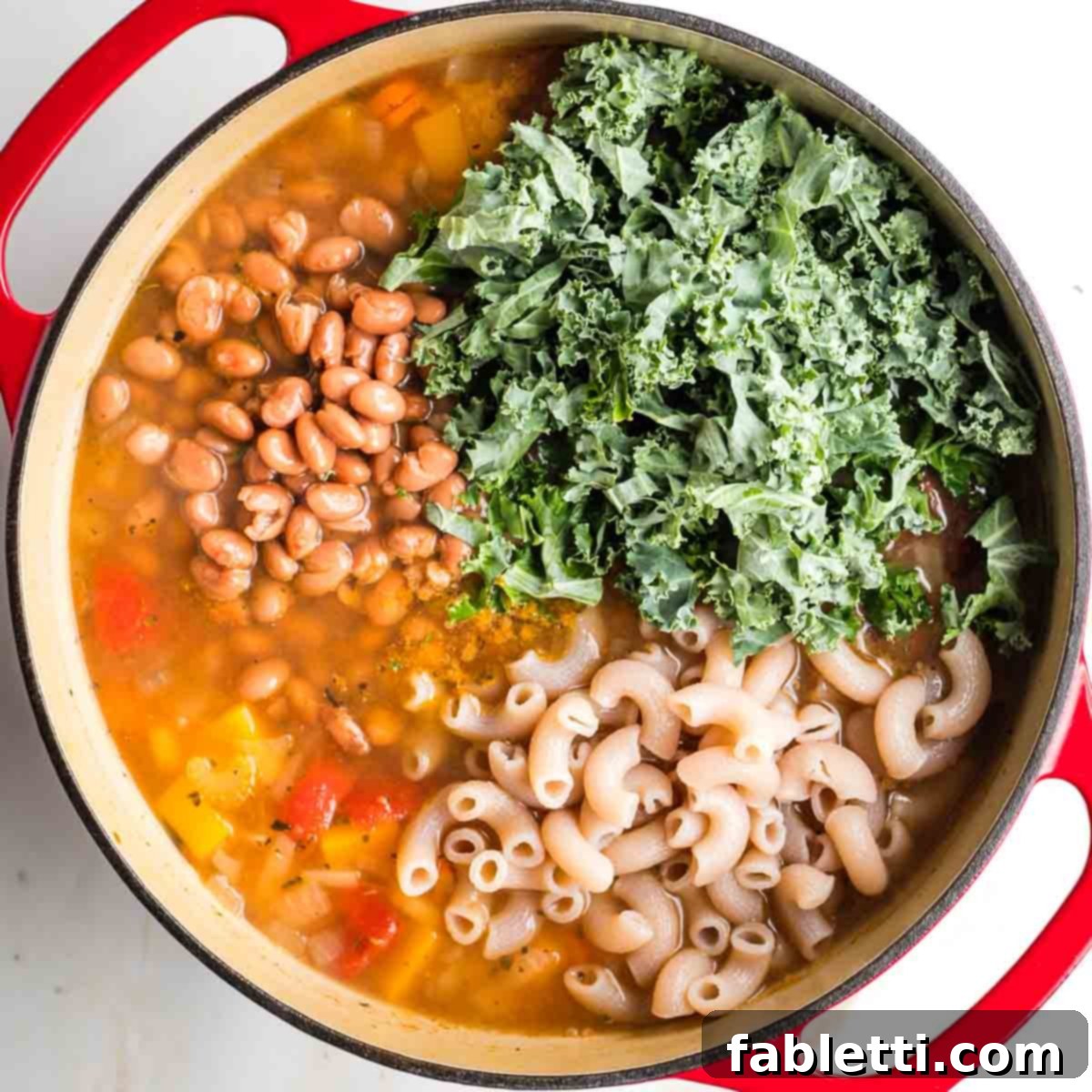
Once the butternut squash is tender and the soup has simmered to perfection, it’s time for the final additions. Add the pre-cooked and thoroughly drained pasta, along with the rinsed and drained beans, and the roughly chopped kale to the soup. Stir everything together gently until thoroughly combined. The residual heat from the simmering soup will be sufficient to gently wilt the kale, infusing the soup with its vibrant color and essential nutrients without overcooking it.

Turn off the heat. Finally, taste the minestrone and adjust the seasonings as needed. This is your chance to make it absolutely perfect for your palate. Add a bit more sea salt if desired, freshly ground black pepper for a subtle bite, or for a delightful subtle kick, sprinkle in some crushed red pepper flakes. Remove the bay leaves before serving, as they have now imparted all their flavor. Serve hot and savor the comforting, rich flavors of this homemade fall minestrone!
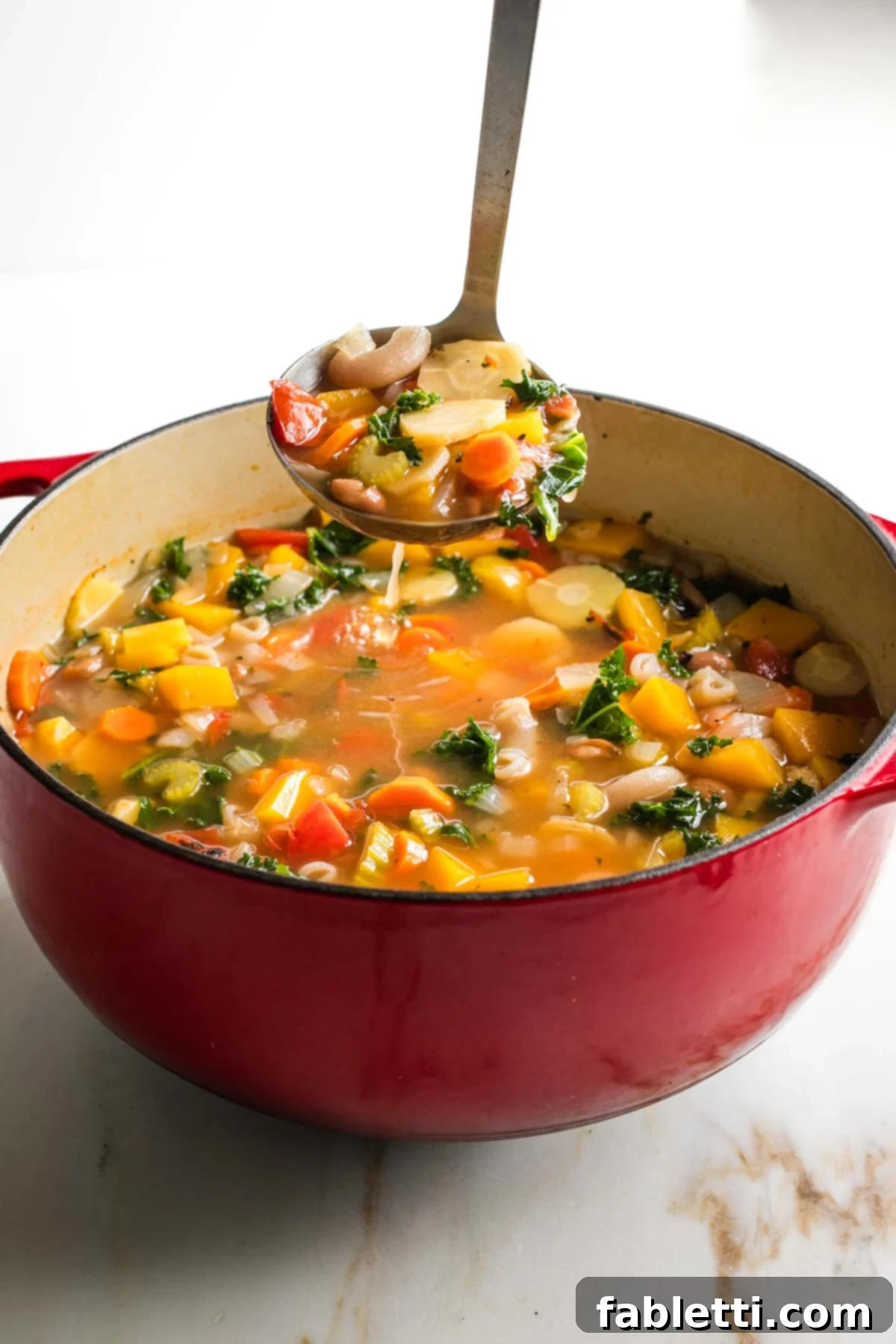
Expert Tips for the Perfect Vegan Minestrone
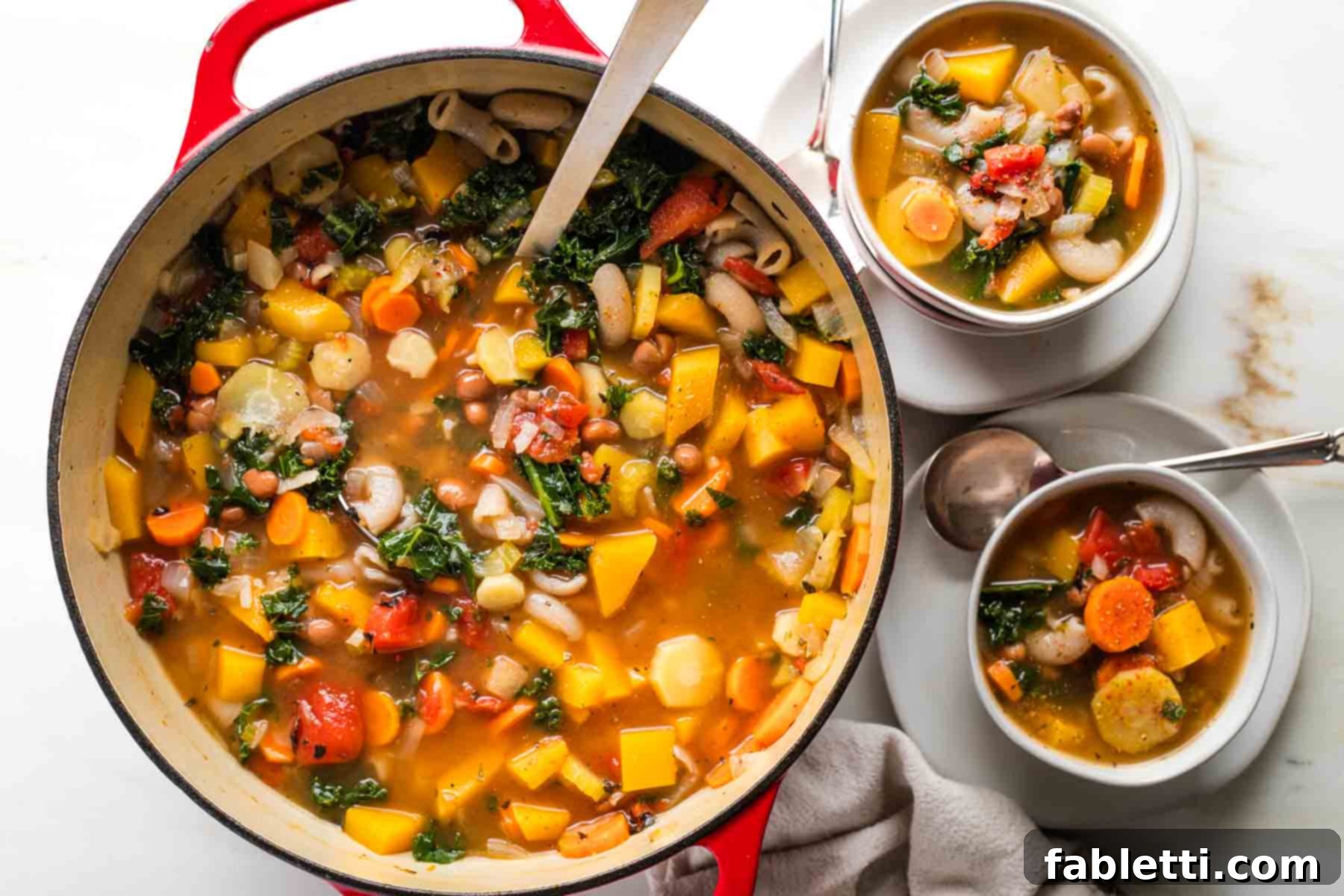
Perfectly Cooked Pasta
Always cook your pasta al dente (firm to the bite) to prevent it from becoming mushy, especially if you plan on storing leftovers. This is particularly important with gluten-free pasta, which can often cook faster than traditional varieties due to different starch compositions. Start testing for doneness about 2 minutes before the package directions suggest. Cooking pasta separately also helps maintain the soup’s broth consistency and volume, as pasta tends to absorb a significant amount of liquid as it cooks and sits.
Control Your Sodium with Homemade Broth
Using my easy recipe for homemade vegetable broth gives you complete control over the amount of salt in your soup. This is a significant advantage for those monitoring sodium intake or who simply prefer to adjust seasoning to their exact taste preferences without worrying about an overly salty base. If you opt for store-bought broth, be mindful that many brands are high in sodium, so you might need to adjust your added salt accordingly, potentially reducing it, to prevent your soup from becoming too salty.
Add a Kick of Spice
If you enjoy a bit of heat, transform this comforting minestrone into a spicy delight! Simply sprinkle in some crushed red pepper flakes or a pinch of cayenne pepper during the final seasoning stage, or when sautéing the aromatics to infuse the whole soup. For a different kind of warmth and a touch of tangy brightness, a squirt of sriracha sauce stirred in at the end works wonderfully. Adjust the amount of spice to your preferred level, starting small and adding more as desired.
Meal Prep & Storage Excellence
This minestrone is an ideal candidate for meal prepping, as its flavors meld and deepen beautifully over time. It will keep wonderfully in an airtight container in the refrigerator for up to a week, making it perfect for lunches or quick dinners. For longer storage, it can be frozen for up to three months. Be aware that the pasta will continue to absorb liquid as the soup sits, especially in the refrigerator. When reheating, you might need to add a splash of extra vegetable stock or water to achieve your desired consistency and rehydrate the pasta.
Creative Customizations for Your Palate
Feel free to make this recipe truly your own! Add other seasonal vegetables like thinly sliced zucchini, chopped green beans, or fresh spinach during the last 10-15 minutes of simmering. Boost the protein further with additional beans, or for a touch of umami and cheesy flavor, sprinkle in some nutritional yeast. Fresh herbs like finely chopped parsley or basil, added just before serving, can also brighten the overall taste and add a fresh aromatic finish.
Your feedback is invaluable and helps other home cooks! If you’ve enjoyed making this nourishing recipe, please consider leaving a five-star rating and a comment below to share your experience. We absolutely love seeing your culinary creations, so don’t forget to share your photos on Instagram by tagging @dkhealthcoach and proudly using the hashtag #debraklein.
📖 Recipe: Fall Harvest Minestrone Soup
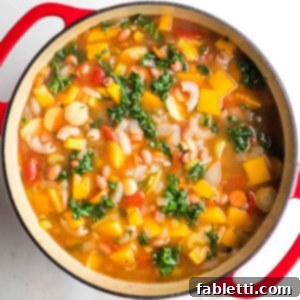
Fall Harvest Minestrone Soup
Author: Debra Klein
Hearty Vegan Minestrone Soup that will fill you up without weighing you down! Easy to make, incredibly delicious, and packed with nutrients for a healthy, satisfying meal.
Rate this Recipe
Pin Recipe
10 mins
30 mins
40 mins
Soup
American, Italian
6 Servings
185 kcal
Ingredients
- 1 yellow onion, diced
- 2 carrots, peeled and thinly sliced
- 2 stalks celery, thinly sliced
- 2 parsnips, peeled and thinly sliced
- 1 Tablespoon Italian spices (any combo of oregano, basil, thyme, marjoram, parsley, rosemary)
- ½ teaspoon sea salt (adjust to taste)
- ¼ teaspoon freshly ground black pepper (adjust to taste)
- 4 cloves garlic, finely grated or pressed
- 1 butternut squash, peeled, seeded, and diced (about 3 cups diced)
- 1 (14.5-oz) can diced tomatoes, undrained
- 1 (14.5-oz) can kidney beans, rinsed and drained (or pinto beans, chickpeas, cannellini beans)
- 8 cups vegetable stock (preferably low sodium or homemade)
- 2 bay leaves
- ¾ cup dried pasta* (small shapes like elbows, ditalini, or small shells)
- 2 cups chopped kale, thick ribs removed
*Pasta Note: For best results, cook pasta separately to al dente (slightly firm) texture. If cooking pasta directly in the soup, add an additional 2 cups of liquid (broth or water) to maintain soup consistency.
Instructions
- Prepare Vegetables: Dice the onion and celery. Peel and thinly slice carrots and parsnips. Peel, seed, and dice the butternut squash (refer to visual steps above for detailed tips on preparation). Peel garlic cloves and roughly chop the kale, ensuring thick ribs are removed for better texture.
- Sauté Aromatics: Heat a dutch oven or large soup pot over medium heat. Sauté the diced onion in a tablespoon of olive oil or vegetable broth until softened, about 3-5 minutes. Add the carrots, celery, parsnips, Italian spices, and ½ teaspoon of sea salt. Cook, stirring for about 5-7 minutes, allowing the vegetables to soften gently. If the pan becomes too dry, add a tablespoon of veggie broth at a time to prevent sticking and deglaze.
- Add Garlic, Tomatoes, and Stock: Grate or press the garlic directly into the pot and stir well for about 30 seconds until fragrant (be careful not to burn it). Immediately add the diced tomatoes (with their juices), diced butternut squash, and bay leaves. Pour in the 8 cups of vegetable stock. Mix thoroughly to combine, bring the soup to a gentle boil, then reduce the heat to a simmer. Cover the pot and cook for 20 minutes, or until the squash is tender when pierced with a fork.
- Cook Pasta Separately: While the soup simmers, cook the dried pasta in a separate pot of salted boiling water according to package directions. Aim for an al dente texture (cook for 2 minutes less than recommended, especially for gluten-free pasta, which cooks faster). Drain the pasta thoroughly.
- Combine & Finish: Once the squash is tender, stir the cooked and drained pasta and the rinsed, drained beans into the soup. Continue stirring gently until everything is thoroughly heated through. Turn off the heat, add the chopped kale, and stir gently as the kale wilts from the residual heat of the soup. Remove the bay leaves before serving.
- Season to Taste: Finally, taste the minestrone and adjust seasonings as needed to suit your preference. Add more salt, freshly ground black pepper, or a pinch of crushed red pepper for a touch of heat.
- Storage: This soup stores exceptionally well. Keep leftovers in an airtight container in the refrigerator for up to a week, or freeze for up to 3 months. Note that pasta will absorb more liquid over time; add a splash of extra stock or water when reheating if a thinner consistency is desired.
Notes
For detailed visual guidance on peeling and cutting butternut squash, refer to the step-by-step photos provided earlier in the article. These visuals can make the preparation process much easier and more efficient.
Pasta Choices: When selecting pasta, use gluten-free pasta if you have dietary restrictions or preferences. Regardless of type, always check for doneness about 2 minutes before the package instructions to ensure an ideal al dente texture, preventing it from becoming overly soft or mushy in the soup, especially for leftovers.
Nutrition Information (Approximate per serving)
Calories: 185 kcal
Carbohydrates: 41g
Protein: 5g
Fat: 1g
Saturated Fat: 0.2g
Polyunsaturated Fat: 0.3g
Monounsaturated Fat: 1g
Sodium: 225mg
Potassium: 795mg
Fiber: 7g
Sugar: 8g
Vitamin A: 17393 IU
Vitamin C: 44mg
Calcium: 112mg
Iron: 2mg
The nutrition calculations provided here are estimates based on online tools and general ingredient databases. For the most accurate nutritional information, we highly recommend calculating with the specific brands and quantities of ingredients you use. You are ultimately responsible for verifying the accuracy, completeness, and usefulness of any nutritional data.
Did you try this amazing Fall Minestrone Soup? We’d absolutely love to hear from you! Please consider leaving a review below and snap a picture of your delicious creation. Share it on Instagram by tagging @dkhealthcoach and using the hashtag #debraklein so we can see your wonderful results and share in your culinary success!
